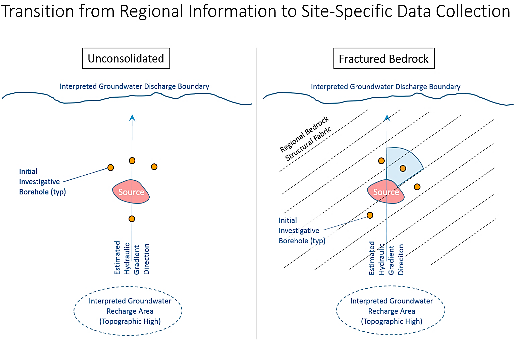5.4 Define Data Collection Objectives and Design Data Collection Process
Once the data gaps are identified, investigators can establish specific data collection objectives and design the data collection process. Data collection objectives are used to determine specific data needs and to select tools and techniques to be used in the investigation. This section describes data collection objectives common to many fractured rock sites, as well as the design of the data collection process and key factors that should be considered in the characterization planning.
5.4.1 Establish Data Collection Objectives
Once the significant data gaps are identified, specific data collection objectives can be established. A more detailed discussion on data collection objectives is included in Integrated DNAPL Site Strategy (ITRC 2011) and Integrated DNAPL Site Characterization and Tool Selection (ITRC 2015b). The data collection objectives depend on the purpose and stage of the characterization. For example, the data collection objectives developed as part of a remedial investigation may differ from those developed for assessing the effectiveness of remedial alternatives.
Data collection objectives should be clear, focused, and specific. Objectives should account for factors such as fracture orientation, spacing and aperture, hydraulic head, and flow velocity. These characteristics define the type of data needed, the data density and spatial resolution, and measurement and analytical resolution. As these objectives become more focused, they help to determine the type of data quality (quantitative, semiquantitative, or qualitative) required to meet the data collection objective and thus the appropriate investigative tools.
The fourth significant data gap noted in Table 5-1 is: the rate at which the deepest and farthest contamination is moving. Based outcrop mapping and available structural maps, a number of fractures, or other planar features, are oriented toward down gradient water supply wells. However, VOC data collected from a deep-water supply well indicate contamination is sidegradient to the assumed flow direction. The data collection objectives in this situation may be as follows:
- Document the orientation of fractures sets in the subsurface to the base of the deepest screened water supply well.
- Define the interconnectivity of fractures.
- Measure the flow velocities in discrete borehole intervals.
- Calculate the groundwater gradient between the source area and water supply wells.
Another example of a significant data gap, with corresponding specific characterization and data collection objectives, is presented below:
Significant Data Gap: The vertical and lateral extent of dissolved phase contamination is unknown.
Characterization Objective: Determine the lateral and vertical extent of dissolved phase VOCs.
Data Collection Objective: Gather data, including fracture location, orientation, connectivity, and VOC concentration in areas beneath the source and between the source and the water supply wells.
The data characterization process is shown in Figure 4-1 of the DNAPL site characterization guidance (ITRC 2015b).
5.4.2 Design Data Collection Process
After establishing the data collection objectives, the next step is to design the data collection process. Designing or developing this process begins before the selection of investigation tools, and is an integral and iterative process within the selection of investigation tools. The design includes sequencing and planning characterization activities. Additionally, the process is optimized to ensure representative data, identify cost-effective approaches, and prevent the spread of contamination during the investigation activities. The sequencing and approach developed from this process should be incorporated into the project work plan.
In general, the data collection process should begin with available data and data obtained through nonintrusive evaluations. These findings can then be used to plan intrusive measures (such as boreholes) if needed. Thus, the initial steps should include the components of the terrane analysis that use available resources and techniques, such as: topographic and geologic maps, light detection and ranging imagery (LiDAR), and aerial photography, to conduct activities such as lineament analyses and initial cross-sections construction. Minimally intrusive or nonintrusive field activities should follow, including surface reconnaissance techniques (such as mapping, outcrop analyses, and measurements) and surface geophysical surveys (such as ground penetrating radar and electrical resistivity).
These results may indicate the need for intrusive methods. For fractured rock characterization, subsurface data are collected using existing boreholes and wells, or a borehole or well installation program to supplement the existing data. The number and locations of data points may be selected subjectively at first, but several approaches can bring objectivity to the selection process. In selecting subsurface data collection locations, first consider how the general structure, or fabric, of the terrane and fracture orientations may affect groundwater flow and contaminant migration.
An example of selecting fractured rock (Appendix C) locations is presented in Figure 5-1. After reviewing available site information, potential source area locations may be mapped and initial investigative borehole locations can be selected. This decision may differ between boreholes drilled in unconsolidated deposits versus those that may need to be drilled in fractured rock, as illustrated. The general regional bedrock structural fabric (strike and dip) is considered, and the array of bedrock drilling locations can be rotated toward the structural fabric orientation, with the amount of rotation determined by the dip angle of the fabric. Generally, there is no rotation with horizontal or subhorizontal dip, and more rotation with steeper dips. In general, the middle of the downgradient monitoring well array should be within the acute angle defined by the estimated hydraulic gradient direction and a line drawn parallel to the dipping regional bedrock structural fabric through the interpreted source.

Figure 5‑1. Selection of Initial Fractured rock Drilling Locations
The number and locations of data collection points needed cannot be predicted. Investigators should consider the number, type and amount of data required as part of the next field investigation to further refine the CSM. After several iterations of this process of data collection and evaluation, the number and locations of data become adequate to support informed decision-making, the significant data gaps are resolved, and the CSM is refined. The most recently collected data might not materially change the CSM, which indicates that the CSM may be adequate for future decision making. Judgments regarding data adequacy in terms of number and location are usually qualitative, may involve many stakeholders, and depend on the characterization objectives for the given stage of the project.
The factors listed below should be considered when designing a data collection process, selecting characterization tools, and developing the overall approach and sequencing of the process.
Using existing wells or boreholes with long open intervals ▼Read more
Strategies for borehole/well installation programs ▼Read more
Precautions and management of long open boreholes during a drilling program ▼Read more
DNAPL contingency planning ▼Read more
Data collection during borehole advancement ▼Read more
Table 5‑2. Rock quality designations (QJEG 2007)
| RQD | Rock Mass Quality |
|---|---|
| <25% | completely weathered rock |
| 25-50% | weathered rock |
| 50-75% | moderately weathered rock |
| 75-90% | Hard rock |
| 90-100% | fresh rock |
Data collection after borehole drilling, prior to well or casing installation ▼Read more
Borehole Completion ▼Read more
Characterization of uppermost bedrock ▼Read more
Characterization activities using wells or multilevel monitoring systems– types of data collection activities ▼Read more


